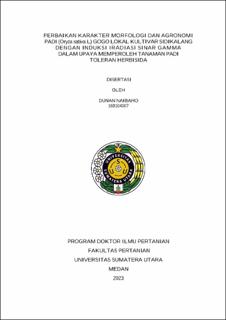| dc.description.abstract | The existence of upland rice in North Sumatra is still far from being empowered while the availability of non-irrigated land is still sufficient and climate change conditions tend to be dominant in the dry season so that the role of upland rice is expected to be able to support national food security. However, the presence of weeds in upland rice cultivation can reduce yields by around 87%.
Weed control using herbicides can be considered more effective, efficient and faster than others but has an impact on the main crop. Induction of gamma irradiation (mutation) can increase genetic diversity so that it can be used to improve plant characters with desired traits, for example plant character for herbicide resistance. This study aims to: (1) obtain rice species that are sensitive to glyphosate herbicide and by induced gamma irradiation genetic variability (herbicide tolerance) ; (2) occurs and determine the LD-50 value as a basis for determining the dose of irradiation treatment in future studies; (3) obtain the response of plant growth and development due to low doses of gamma irradiation, through changes in morphophysiological and agronomic characters in the M1 generation, heritability and genetic variabibity in the M2 generation and selection genotypes with good morphology and agronomic characteristics in the M3 generation; (4) obtaining mutant plants (M3) upline rice cultivar Sidikalang that were tolerant to glyphosate herbicide; (5) identification of genetic variability of upline rice cultivar Sidikalang induced by gamma irradiation based on RAPD molecular markers.
This research consisted of five stages, namely: (1) Screening the sensitivity of several genotype of local upland rice of North Sumatra to the application of glyphosate herbicide by using the non-factorial Randomized Block Design (RBD) research method; (2) radiosensitivity and the effect of gamma irradiation on up-line rice genotype Sidikalang; (3) Variation of agronomic characters of upline rice cultivar Sidikalang and genotypic selection of mutants resulting from low doses of gamma-ray irradiation. This study consists of three experiments, namely: (3.1) The effect of low-dose gamma-ray irradiation, (3.2) variation of agronomic characters of the M2 generation resulting from low-dose gamma-ray irradiation, (3.3) Selection M3 mutant genotypes for morphology and agronomic characters; (4) Glyphosate herbicide tolerance test of upline rice cultivar Sidikalang as a result of screening by induction of low doses of gamma-ray irradiation. This research method used a non-factorial randomized block design (RBD) with six replications ; (5) Study of genetic variability on upline rice cultivar Sidikalang resulting from gamma-ray irradiation based on random amplified polymorphic DNA (RAPD) molecular markers. The stages of analysis were carried out by DNA isolation, electrophoresis and PCR amplification with 4 RAPD primers.
The results of the sensitivity screening experiment of several types of upland rice showed that there were differences in the response of growth and development of six types of local upland rice genotype to the application of glyphosate herbicide. Genotype Sidikalang has the lowest percentage of live plants (sensitive) compared to other genotypes and the LD-50 value of rice genotype Sidikalang is 586.446 Gy.
The results of low-dose gamma irradiation (M1) produced three irradiated populations (200 Gy, 400 Gy, and 600 Gy) which showed morphological, anatomical, physiological and production characters that were different from the control population.
The results of research on the M2 generation showed that the resulting genetic variability for each character was different from each irradiated population. The high heritability (H2) value was found in the characters (plant height, number of leaves, number of tillers, panicle emergence, number of panicles, and panicle length), and the wide coefficient of genetic variation (CGV) was found in the number of tillers and number of panicles. Selection of selected individuals in the M3 generation was based on the characteristics of plant height, number of tillers, the age at which panicles were released and the number of panicles which resulted in an improvement in the mean value of the selected genotype compared to the mean value of the basic population from the M3 generation.
The results showed that there were different morphological responses of each population to the glyphosate herbicide application in the M3 generation and the gamma irradiated population and the control population. The results showed that there were different morphological responses from each dose of radiation treatment, namely 0 Gy, 200 Gy, 400 Gy, 600 Gy to plant height, number of tillers to the effect of herbicide on the percentage of the number of living plants with the mechanism of changing the target site through testing the acid content amino tryptopan, tyrosine and phenylalanine at each dose of radiation treatment. The highest percentage of living plants from 3 week after application (WAA)-5 WAA was found in the 200 Gy irradiation dose.
The results showed that the DNA amplification of the up-line rice cultivar Sidikalang DNA resulting from gamma irradiation (200 Gy, 400 Gy, and 600 Gy) using RAPD markers produced a polymorphic band pattern with the most polymorphic DNA bands in the OPD 20 primer (7 bands) at a radiation dose of 600 Gy and the fewest DNA bands on the OPM 01 primer (2 bands). | en_US |


